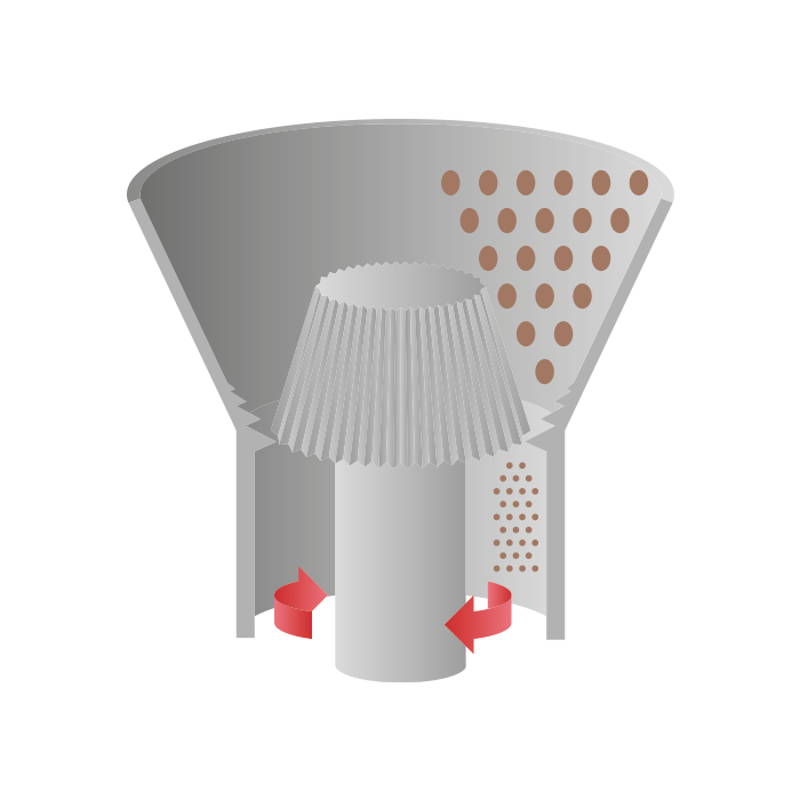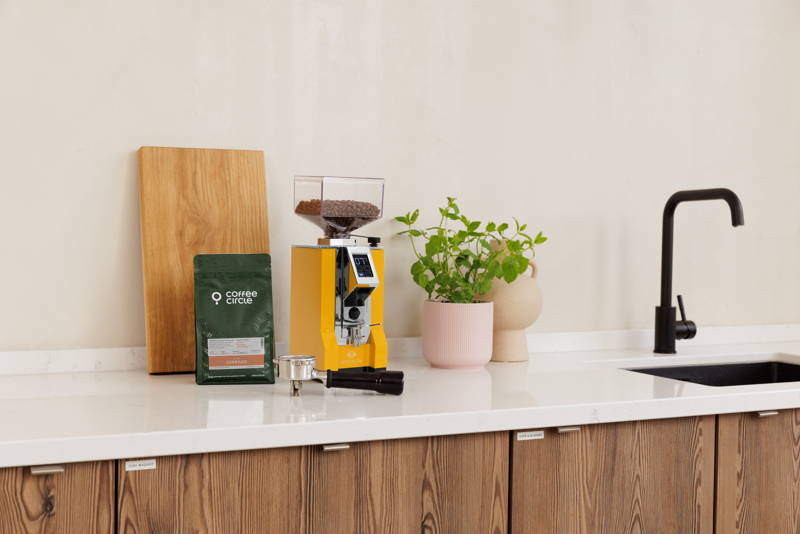
15 espresso grinders tested
Do you want to get the full flavor out of your espresso? Then you’ve come to the right place, because freshly ground coffee tastes best. We at Coffee Circle have taken a close look at 15 espresso grinders and tested them extensively to help you find the right grinder for your needs. Here we present our top 3 espresso grinders and 6 others that are a good alternative.
15 espresso grinders tested

You only have 1 minute? These are our top 3:
Coffee grinders for beginners
In our opinion, the Sage offers the best value for money and delivers an excellent result for the price. For anyone new to the world of coffee or looking for a good grinder at an affordable price.
For advanced espresso fans
The Eureka Specialità has exceeded our expectations. With its large disc grinder, the grinder achieves very homogeneous grinding results. We recommend the grinder to anyone who has high demands on their coffee.
For professionals
The Rocket Giannino is the high-end grinder for those with the highest demands. We were particularly impressed by the homogeneity of the ground coffee, but it also delivered above-average results in all other categories.
How to identify a good coffee grinder
Coffee is a fresh product and loses flavour shortly after roasting. So to enjoy your coffee to the full, you should buy coffee beans and grind them fresh in portions shortly before preparation.
Are you looking for a checklist for a good espresso grinder, information on our test procedure or further background knowledge?

Our top 3
Our test results
In the following section, you will find all the important information about the espresso grinders that we recommend for your coffee corner. We have tested grinders from the brands Sage, Fellow, Rancilio, Graef, Eureka, Baratza, Wilfa, Rocket, Mahlkönig and ECM.
Coffee grinders for beginners
The grinders tested in this category are affordable and offer a good mix of intuitive operation and good grinding results.
Test winner for beginners: Sage Smart Grinder Pro The affordable all-rounder
Grinder: 40 mm stainless steel cone grinder | Grinding degrees: 60 | Loudness: relatively loud
The Sage Smart Grinder Pro impressed us with its value for money: it performed well in all the tests. This makes it ideal for all espresso beginners and anyone looking for good grinding results at an affordable price.
Pro:
- Great price-performance ratio
- Extensive range of accessories
- Many instructions for beginners
Contra:
- Relatively more favorable processing
- Loud noise at the end of the grinding process




Alternative for beginners
Fellow Opus Grinder The modern grinder for home use
Grinder: 40 mm stainless steel cone grinder | Grinding degrees: 41+ | Loudness: quiet
The Fellow Opus also impressed us in the lower-priced segment. It impresses with its modern and elegant design and has little dead space thanks to its construction. It can be operated intuitively, but some compromises have to be made when it comes to the grinding results.

Contra:
- Grinding speed very slow
- Unhandy grind adjustment
- Grinding result could be improved
Coffee grinders for advanced users
If you have higher demands for your favorite espresso, you can’t avoid a high-quality espresso grinder. The following grinders are all of high quality and each convinced us in its own way.
Test winner for advanced users: Eureka Specialità For coffee nerds and all those who want to become one
Grinder: 55 mm stainless steel disk grinder | Grinding degrees: infinitely adjustable| Loudness: very quiet
The Eureka Specialità impressed us at first glance with its elegant design. But it also achieved very good results in every criterion we tested. The grinder is ideal for anyone who values a high-quality look but doesn’t want to miss out on a good espresso.
Contra:
- Challenging grind setting
- Operating the display takes some time getting used to




Alternatives for advanced users
Baratza Sette 270 The innovation from Baratza
Grinder: 40 mm stainless steel cone grinder | Grinding degrees: 270 | Loudness: loud
The Baratza Sette impresses with its sophisticated design and good grinding results. It is a good alternativein the mid-range price segment for coffee lovers who value ease of use and are not bothered by a somewhat louder grinder.

Contra:
- Challenging grind setting
- Plastic housing
- High volume
Wilfa Uniform Modern grinder in coffee can look
Grinder: 58 mm stainless steel disc grinder | Grinding degrees: 41 | Loudness: very quiet
The Wilfa Uniform looks perfect in your coffee corner and comes with the most important basics. It is also space-saving and very quiet, making it ideal for apartments with good acoustics.
Contra:
- Low grinding speed
- Difficult to find the grinding degree
- Static ground coffee
Coffee grinders for professionals
These grinders are for all coffee enthusiasts who have the highest demands on their espresso and are looking for a grinder with excellent grinding results.
Test winner for professionals: Rocket Espresso Giannino The high-end grinder from the Italian classic
Grinder: 55 mm stainless steel disk grinder | Grinding degrees: infinitely adjustable | Loudness: quiet
The Rocket Giannino is the high-end grinder for espresso enthusiasts who don’t want to miss out on anything in their coffee corner at home. Excellent grinding results, little dead space and a high grinding speed – the Rocket Giannino combines all of this.
Pro:
- High grinding speed
- Homogeneous ground coffee
- Low temperature development
- Little dead space
Contra:
- Sputum clogs easily
- No intuitive operation



Alternatives for professionals
Eureka Mignon Single Dose The ultimate in single-dose grinder
Grinder: 65 mm stainless steel disk grinder | Grindingdegrees: infinitely adjustable | Loudness: relatively loud
The Eureka Mingon Single Dose is the ideal grinder for any professional looking for a high-quality and durable Single Dose grinder. With its stylish wooden accents, it is an eye-catcher in any kitchen. In the test, the grinder particularly impressed with its excellent homogeneity, minimal dead space and grinding speed.

Contra:
- Small hopper
- Increased volume
Baratza Forté AP Long lasting high-end model from Baratza
Grinder: 54 mm ceramic disk grinder | Grinding degrees: 260 Loudness: loud
The Baratza Forté AP scored particularly well with its ease of use – even if a longer training period is required. Various presets can be easily saved and recalled via the display. Although the grinder does not have a stepless grinder, the Bartatza Forte can be set and replicated extremely precisely with 260 grinding degrees, so that it is very easy to switch between different types of espresso.
Pro:
- High grinding speed
- Large selection of grinding degrees
- Grinding degree setting easily replicable
Contra:
- High temperature development
- Sophisticated grind adjustment

Why a good espresso grinder is important:
Pre-ground coffee quickly loses its aroma:
Coffee loses its aroma just a few minutes after grinding. So you can imagine how this affects pre-ground coffee that you store for several weeks. To avoid this, we recommend buying your coffee as a whole bean and using it up within a short time. Only grind as much as you need for the preparation before you start. With your own espresso grinder, you can adjust the grind of your coffee depending on the roast to ensure optimum extraction.
But not all grinders are the same. There are many differences between the various grinders, such as different grinding mechanisms, performance and handling of the grinder and care requirements.
Please note: The grinders listed here cover fine grinds, which are ideal for making espresso. For filter coffee fans, we have therefore put coffee grinders through their paces in a separate test.

Price-performance winner among the Single Dose grinders: Varia VS3
Grinder: 48 mm stainless steel disk grinder | Grinding degrees: infinitely adjustable | Loudness: loud
As part of our espresso grinder test, we examined Single Dose grinders, among other things. The Varia VS3 emerged as the price-performance winner. The Single Dose grinder was particularly impressive in terms of dead space, as this is non-existent, putting it in first place among all grinders. Furthermore, the temperature of the ground product did not increase drastically even after several grinding processes.
Contra
- Unpleasant grinding noise
- Static ground coffee
- Sputum clogs easily



Your checklist for a good espresso grinder: What should you look out for when buying your grinder?
- Homogeneous grinding: Uniformly ground coffee with a low proportion of fine dust
- Low temperature development: If too much heat is generated, the oils in the coffee change & and so does the flavour.
- Low dead space: So your ground coffee is always as fresh as possible.
- Stepless grind adjustment: Ideal for finding the perfect grind
- Optional: Grinding speed, volume
This is how we tested:
For a detailed test, we examined the following aspects of the grinders:
- Quality of the ground material
- Dead space
- Handling & user-friendliness
- Processing the grinder
- Cleaning the grinder
- Taste of the ready-brewed coffee


To begin with, we set all the grinders identically so that we could pull an aromatic espresso from our La Marzocco in the ideal time. We carried out the test with our Grano Gayo as the darker roast and our Cerrado as the lighter roast.
First and foremost, we focused on the quality of the grinding result. On the one hand, the particle distribution and the homogeneity of the ground material are of primary importance. We used a Keck Sand Shaker for this investigation. In this, different fine sieves are arranged on top of each other, which make it possible to separate coffee particles of different sizes from each other.
To do this, we shook 8 g of coffee in the shaker until no more coffee particles fell to the bottom of the appliance (approx. 5 minutes). When selecting the sieve sizes, it was important to us that hardly any coffee particles collect on the two outer sieves.


The graph shows how evenly the test grinders grind. The X-axis shows the size of the coffee particles in mm, whereby we consider all particles smaller than 0.23 mm to be fine dust. The Y-axis illustrates the percentage weight of the particles in the respective size range as weighed by us.
Ideally, a large proportion of the coffee particles should lie in one area. The higher the peak of the curve, the more homogeneous the ground coffee. In addition, the deviation from this „ideal size“ should also be as small as possible, i.e. the largest possible proportion of particles should collect in the areas around the peak. In addition, the proportion of fine dust, i.e. the weight in the area smaller than 0.23 mm, should be as low as possible. You can find more information here.
To evaluate the ground product, we also measured the temperature development during repeated grinding processes in two runs.
Another part of our test was to examine the dead space of the grinders. To do this, we took a single shot from the new grinders and weighed up how much coffee came out. We also unscrewed all the grinders and brushed out the ground coffee that had collected there and weighed it up.


To assess the user-friendliness and handling, we considered, for example, how intuitive the grinder is to use, how easy it is to set a suitable grinding degree and whether this can be easily replicated.
The processing of the grinder focused on the material of the grinder and the grinding mechanism, as well as the design of the grinder.
We also included in our test how easy it is to disassemble the grinders for thorough cleaning.
In the end, of course, it is always the taste of the coffee that decides. To do this, we consulted baristas from our cafés, who evaluated various samples.

Why you can trust us:
We love coffee and spend the whole day with nothing else but our favorite drink. Our journey into the world of coffee began in 2010 and we have learned a lot since then. From growing and roasting to preparing really good coffee, we want to share our knowledge with you. We only recommend products that we would also recommend to our friends.
We have many of the products featured in the test in our range. Is the test still objective?
Yes, we tested many appliances against each other for this grinder test. In addition, no manufacturer paid to be part of the test. That’s why the product tests are a good opportunity for us to see how well our current selection performs on the market. Whenever products convince us in the test, we add them to our store.
Background knowledge
Conical grinder
In grinders with a conical grinder, the coffee beans are ground between the inner cone and the outer wall. The distance between the cone and the surrounding ring becomes smaller and smaller towards the bottom, so that the beans are gradually ground finer and finer until they fall between the grinding cone and the grinding ring. The degree of grinding can be changed via the distance between the cone and the ring. In contrast to a disk grinder, the ground material is not carried to the side, but falls downwards. For this reason, the speed of a cone grinder tends to be lower than that of a disk grinder and the temperature development is correspondingly lower.

Disc grinder
Disc grinders are currently the most commonly used grinders. The beans are ground between two concave grinding disks that lie on top of each other. One of the two disks is driven by a motor and the other disk is fixed. The distance between the two disks is slightly greater on the inside than on the outside. The bean passes from the inside between the disks, is broken up here and then transported further outwards by centrifugal force. As the grinding disks are closer together on the outside, the bean is ground finer and finer. To adjust the degree of grinding, the distance between the disks is changed. The grinding disks are usually made of steel or ceramic and are particularly durable.


Homogeneity of the ground coffee
The quality of the ground coffee and therefore also the quality of a grinder can best be recognized by the homogeneity of the ground coffee. The point is that all coffee particles have a similar size after the grinding process. During extraction, the water takes all the aromatic substances released by the coffee particles with it on its way down before it ends up in the cup as a strong espresso. If the coffee grounds are not homogeneous, this can lead to uneven extraction, which means that some parts of the coffee are over-extracted while others are under-extracted. A homogeneous grind therefore allows the particles to release the same amount of aroma thanks to their equal size and thus contribute uniformly to the taste.
However, perfect homogeneity is not possible on the one hand and not necessarily desirable on the other, because the nuances that some larger and smaller particles bring with them give the espresso character and make each cup unmistakable. Perfect homogeneity is therefore not the goal! Rather, the aim is for a grinder to grind many particles of the same size, leaving room for a few larger and smaller particles.
Dead space
The dead space of a grinder is the empty space in which coffee residue that is not ejected collects during grinding. A distinction can be made between permanent and temporary dead space. The permanent dead space of a grinder is permanent, such as the grooves of a screw. The temporary dead space, on the other hand, is ejected and recut during each grinding process. This can result in old and therefore less aromatic ground coffee being dispensed, which negatively affects the taste of your espresso.














